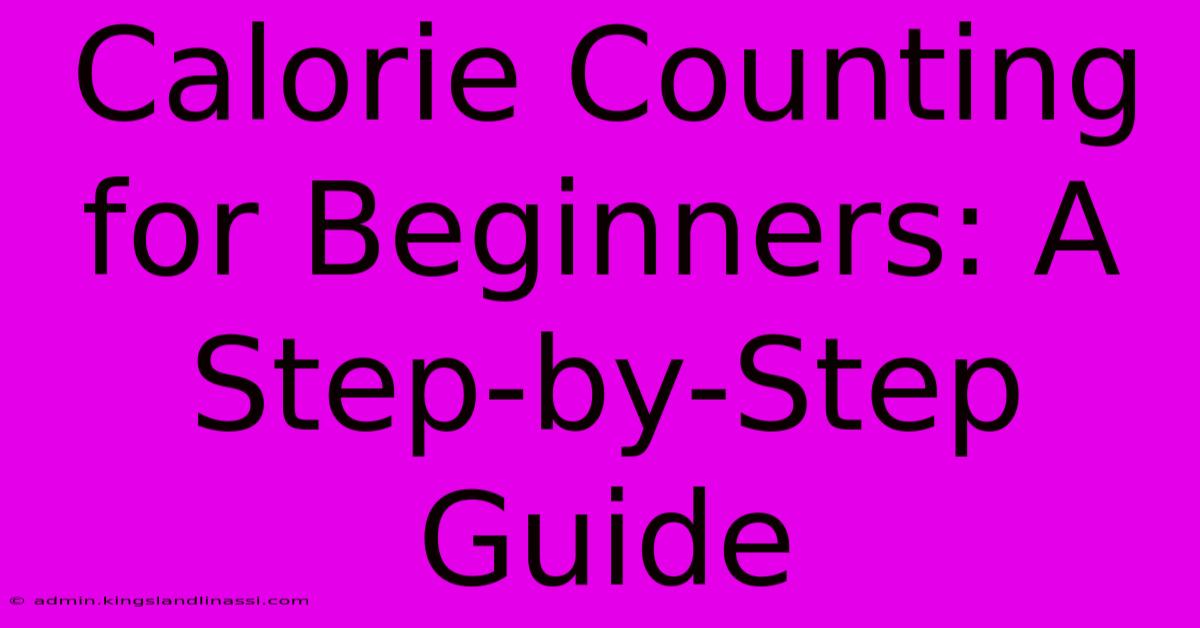Calorie Counting For Beginners: A Step-by-Step Guide

Table of Contents
Calorie Counting for Beginners: A Step-by-Step Guide
Losing weight or maintaining a healthy weight often involves understanding your calorie intake. Calorie counting, while it might sound daunting, is a valuable tool for achieving your fitness goals. This beginner's guide will walk you through the process step-by-step, making it simple and manageable.
What is Calorie Counting?
Calorie counting is simply tracking the number of calories you consume versus the number you burn. A calorie is a unit of energy found in food and drinks. If you consume more calories than you burn, you'll gain weight. Conversely, if you burn more calories than you consume, you'll lose weight. The goal isn't to drastically restrict calories, but to find a sustainable balance.
Step 1: Determine Your Daily Calorie Needs
This is crucial. Estimating your daily calorie needs requires considering several factors:
- Age: Metabolism slows with age.
- Gender: Men generally have higher basal metabolic rates (BMR) than women.
- Height and Weight: Taller and heavier individuals generally burn more calories at rest.
- Activity Level: Sedentary individuals have lower calorie needs than those who are very active. Consider your daily exercise routine.
You can find numerous online calculators that can estimate your daily calorie needs based on these factors. These are just estimates; you may need to adjust based on your progress.
Finding Your BMR (Basal Metabolic Rate)
Your BMR is the number of calories your body burns at rest to maintain basic functions. Many online calculators can help you determine this. This is a good starting point for your calorie counting journey.
Step 2: Track Your Calorie Intake
Now comes the practical part. There are several methods for tracking your calorie intake:
- Food Diary/Journal: The old-fashioned way, but effective! Write down everything you eat and drink, including portion sizes.
- Calorie Counting Apps: Numerous apps (like MyFitnessPal, Lose It!, Cronometer) simplify tracking. These apps often have large databases of foods, making it easier to log your meals. Many also include barcode scanners for quick entry.
- Food Scales: For accuracy, especially in the beginning, using a food scale is highly recommended. This helps you accurately measure portion sizes.
Tips for Accurate Tracking:
- Read food labels carefully: Pay attention to serving sizes and calories per serving.
- Estimate portion sizes if you don't weigh your food: Learn to visually estimate standard portion sizes (e.g., a deck of cards for meat, a tennis ball for fruits).
- Be honest with yourself: Don't underestimate or overestimate your portions. Accuracy is key.
- Don't forget drinks: Sugary drinks contribute significantly to your daily calorie intake.
Step 3: Adjust Your Calorie Intake Based on Your Goals
Once you have a baseline understanding of your calorie intake, you can adjust it to meet your goals. Remember to make gradual changes, rather than drastic cuts.
- Weight Loss: Generally, a deficit of 500-750 calories per day can lead to a safe and sustainable weight loss of 1-2 pounds per week.
- Weight Maintenance: Consume approximately the same number of calories you burn.
- Weight Gain: Consume a surplus of calories, focusing on healthy, nutrient-rich foods.
Step 4: Listen to Your Body
Calorie counting shouldn't be a rigid, restrictive process. Pay attention to your hunger and fullness cues. If you're consistently hungry, you may need to increase your calorie intake slightly. If you feel overly full, you might need to reduce it.
Step 5: Focus on Nutrient-Rich Foods
While calorie counting is important, don't neglect the nutritional value of your food. Focus on eating a balanced diet rich in fruits, vegetables, whole grains, lean protein, and healthy fats. This ensures you're getting the essential nutrients your body needs.
Beyond Calorie Counting: Lifestyle Changes
Calorie counting is a tool, but it's not the only answer. Combine it with a holistic approach to health and wellness:
- Regular Exercise: Incorporate both cardio and strength training for optimal results.
- Sufficient Sleep: Aim for 7-9 hours of quality sleep each night.
- Stress Management: Find healthy ways to manage stress, such as meditation or yoga.
Remember to consult a healthcare professional or registered dietitian before making significant changes to your diet, especially if you have any underlying health conditions. They can provide personalized guidance and support based on your individual needs. Calorie counting is a journey, not a race. Be patient, consistent, and celebrate your progress along the way!

Thank you for visiting our website wich cover about Calorie Counting For Beginners: A Step-by-Step Guide. We hope the information provided has been useful to you. Feel free to contact us if you have any questions or need further assistance. See you next time and dont miss to bookmark.
Featured Posts
-
Hyun Bins Love For Son Ye Jin A Heartfelt Confession
Apr 28, 2025
-
Fixits Net Worth Breaking Down The Numbers
Apr 28, 2025
-
Eva Giris Age Finally Revealed
Apr 28, 2025
-
Blood Pressure Optimization By Age Achieve Wellness
Apr 28, 2025
-
Sam Verzosas 2024 Net Worth The Full Breakdown
Apr 28, 2025
